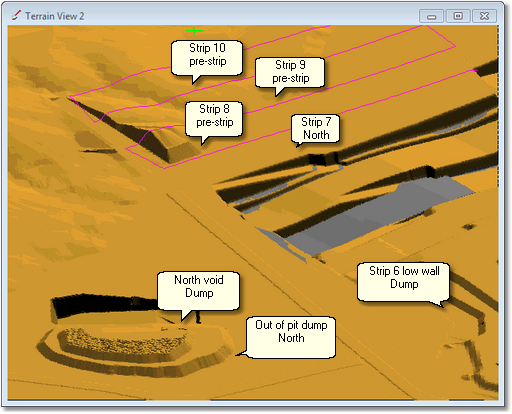|
<< Click to Display Table of Contents >> Dump Assignment Example |
  
|
|
<< Click to Display Table of Contents >> Dump Assignment Example |
  
|
The above procedures for dump assignment are demonstrated here by an example. The example pit has a pre-stripping operation over 3 Strips, plus several waste pass lifts in the main pit. The pre-strip is excavated in a two-lift single pass operation. There are three Dumps available. The figure below shows this operation:

Subsequences for each Strip have been created, and a Supersequence has been created to excavate the three Strips of the pre-strip in operation plus the waste stripping in the main pit. The three Dumps required have been set up as Staged Dumps.
The dumping strategy for the pre-strip operation is for the material to report to three dumps. The first priority is to fill the void left by an old disused pit, North Void Dump. The second priority is to use all available room in an approved dump associated with disused pit, Out of pit dump North. Any remaining pre-strip material will report to the main pit dump area in the Strip 6 low wall Dump.
The main pit waste stripping is conducted in Strip 7. This involves several lifts of waste for the Upper Seam.
The pre-strip operation will utilise the following dump hierarchy:
North void Dump
Out of pit dump North
Strip 6 low wall Dump
The strip 7 waste pass Subsequences will all report to the Strip 6 low wall Dump. This is a large capacity Dump designed to service several subsequent strips and so we can be confident it will accommodate all material, hence no other dumps are required in the hierarchy.
The following video clip demonstrates the procedure for dump assignment. Additionally, after the dumps are assigned, the Supersequence is run using Simulate/Run Supersequence, this demonstrates the Dump Assignment in operation.
At the start of the video the Supersequence is run in Excavate/Start Supersequence mode (no dumping), to illustrate the Supersequence. On completion of the Supersequence the Undo button is used to restore the model. Following this the Dumps are assigned and Supersequence is rerun using Simulate/Run Supersequence: